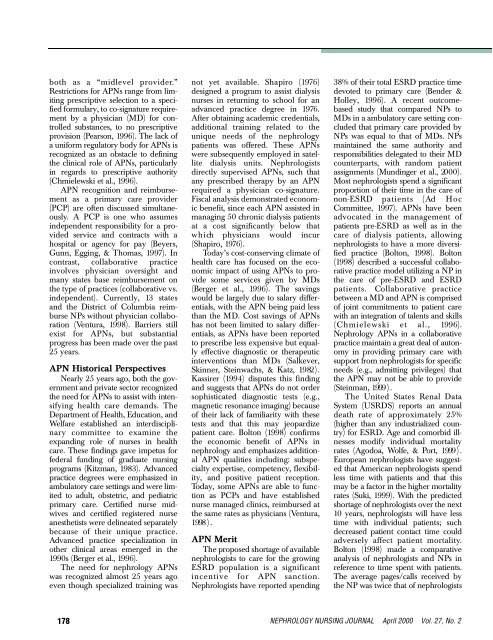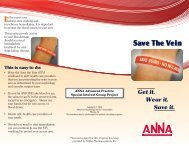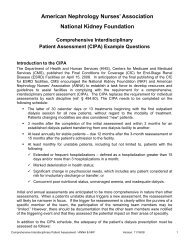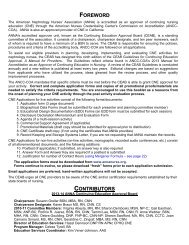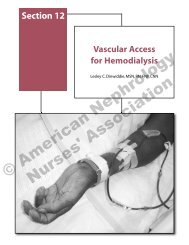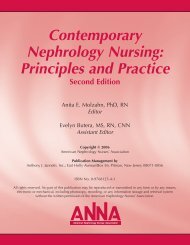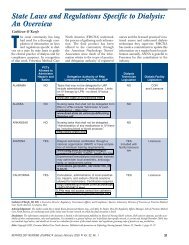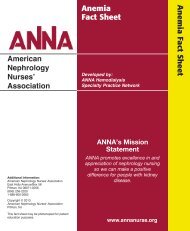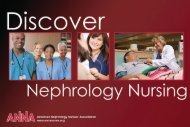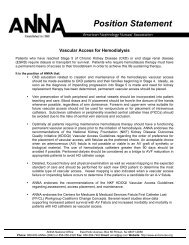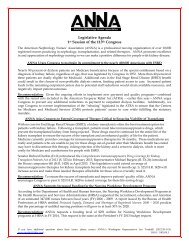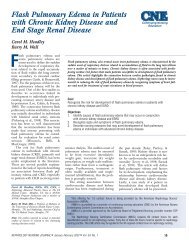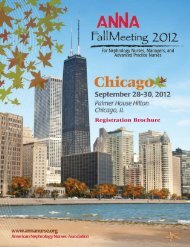Advanced Practice Nurses: Roles in the Hemodialysis Unit
Advanced Practice Nurses: Roles in the Hemodialysis Unit
Advanced Practice Nurses: Roles in the Hemodialysis Unit
Create successful ePaper yourself
Turn your PDF publications into a flip-book with our unique Google optimized e-Paper software.
oth as a “midlevel provider.”<br />
Restrictions for APNs range from limit<strong>in</strong>g<br />
prescriptive selection to a specified<br />
formulary, to co-signature requirement<br />
by a physician (MD) for controlled<br />
substances, to no prescriptive<br />
provision (Pearson, 1996). The lack of<br />
a uniform regulatory body for APNs is<br />
recognized as an obstacle to def<strong>in</strong><strong>in</strong>g<br />
<strong>the</strong> cl<strong>in</strong>ical role of APNs, particularly<br />
<strong>in</strong> regards to prescriptive authority<br />
(Chmielewski et al., 1996 ) .<br />
A PN recognition and reimbursement<br />
as a primary care provider<br />
( PCP) are often discussed simultaneo<br />
u s l y. A PCP is one who assumes<br />
<strong>in</strong>dependent responsibility for a provided<br />
service and contracts with a<br />
hospital or agency for pay (Be y e r s ,<br />
Gunn, Egg<strong>in</strong>g, & Thomas, 1997). In<br />
contrast, collaborative practice<br />
<strong>in</strong>volves physician oversight and<br />
many states base reimbursement on<br />
<strong>the</strong> type of practices (collaborative vs.<br />
<strong>in</strong>dependent). Currently, 13 states<br />
and <strong>the</strong> District of Columbia reimburse<br />
NPs without physician collaboration<br />
(Ventura, 1998). Barriers still<br />
exist for APNs, but substantial<br />
progress has been made over <strong>the</strong> past<br />
25 years.<br />
A PN Historical Pe r s p e c t i ve s<br />
Nearly 25 years ago, both <strong>the</strong> government<br />
and private sector recognized<br />
<strong>the</strong> need for APNs to assist with <strong>in</strong>tensify<strong>in</strong>g<br />
health care demands. The<br />
Department of Health, Education, and<br />
Welfare established an <strong>in</strong>terdiscipl<strong>in</strong>ary<br />
committee to exam<strong>in</strong>e <strong>the</strong><br />
expand<strong>in</strong>g role of nurses <strong>in</strong> health<br />
care. These f<strong>in</strong>d<strong>in</strong>gs gave impetus for<br />
federal fund<strong>in</strong>g of graduate nurs<strong>in</strong>g<br />
programs (Kitzman, 1983). Ad v a n c e d<br />
practice degrees were emphasized <strong>in</strong><br />
ambulatory care sett<strong>in</strong>gs and were limited<br />
to adult, obstetric, and pediatric<br />
primary care. Certified nurse midwives<br />
and certified registered nurse<br />
anes<strong>the</strong>tists were del<strong>in</strong>eated separately<br />
because of <strong>the</strong>ir unique practice.<br />
<strong>Advanced</strong> practice specialization <strong>in</strong><br />
o<strong>the</strong>r cl<strong>in</strong>ical areas emerged <strong>in</strong> <strong>the</strong><br />
1990s (Berger et al., 1996 ) .<br />
The need for nephrology APN s<br />
was recognized almost 25 years ago<br />
even though specialized tra<strong>in</strong><strong>in</strong>g was<br />
178<br />
not yet available. Shapiro (1976 )<br />
designed a program to assist dialysis<br />
nurses <strong>in</strong> return<strong>in</strong>g to school for an<br />
advanced practice degree <strong>in</strong> 1976 .<br />
After obta<strong>in</strong><strong>in</strong>g academic credentials,<br />
additional tra<strong>in</strong><strong>in</strong>g related to <strong>the</strong><br />
unique needs of <strong>the</strong> nephrology<br />
patients was offered. These APN s<br />
were subsequently employed <strong>in</strong> satellite<br />
dialysis units. Ne p h r o l o g i s t s<br />
directly supervised APNs, such that<br />
any prescribed <strong>the</strong>rapy by an APN<br />
required a physician co-signature.<br />
Fiscal analysis demonstrated economic<br />
benefit, s<strong>in</strong>ce each APN assisted <strong>in</strong><br />
manag<strong>in</strong>g 50 chronic dialysis patients<br />
at a cost significantly below that<br />
w h i ch physicians would <strong>in</strong>cur<br />
(Shapiro, 1976).<br />
Today’s cost-conserv<strong>in</strong>g climate of<br />
health care has focused on <strong>the</strong> economic<br />
impact of us<strong>in</strong>g APNs to provide<br />
some services given by MD s<br />
( Berger et al., 1996). The sav<strong>in</strong>gs<br />
would be largely due to salary differentials,<br />
with <strong>the</strong> APN be<strong>in</strong>g paid less<br />
than <strong>the</strong> MD. Cost sav<strong>in</strong>gs of APN s<br />
has not been limited to salary differentials,<br />
as APNs have been reported<br />
to prescribe less expensive but equally<br />
effective diagnostic or <strong>the</strong>rapeutic<br />
<strong>in</strong>terventions than MDs (Salkever,<br />
Sk<strong>in</strong>ner, Ste<strong>in</strong>wachs, & Katz, 1982 ) .<br />
Kassirer (1994) disputes this f<strong>in</strong>d<strong>in</strong>g<br />
and suggests that APNs do not order<br />
sophisticated diagnostic tests (e.g.,<br />
magnetic resonance imag<strong>in</strong>g) because<br />
of <strong>the</strong>ir lack of familiarity with <strong>the</strong>se<br />
tests and that this may jeopardize<br />
patient care. Bolton (1998) confirms<br />
<strong>the</strong> economic benefit of APNs <strong>in</strong><br />
nephrology and emphasizes additional<br />
APN qualities <strong>in</strong>clud<strong>in</strong>g: subspecialty<br />
expertise, competency, flexibility,<br />
and positive patient reception.<br />
Today, some APNs are able to function<br />
as PCPs and have established<br />
nurse managed cl<strong>in</strong>ics, reimbursed at<br />
<strong>the</strong> same rates as physicians (Ve n t u r a ,<br />
1998 ) .<br />
A PN Me r i t<br />
The proposed shortage of available<br />
nephrologists to care for <strong>the</strong> grow<strong>in</strong>g<br />
ESRD population is a significant<br />
<strong>in</strong>centive for APN sanction.<br />
Nephrologists have reported spend<strong>in</strong>g<br />
38% of <strong>the</strong>ir total ESRD practice time<br />
devoted to primary care (Bender &<br />
Holley, 1996). A recent outcomebased<br />
study that compared NPs to<br />
MDs <strong>in</strong> a ambulatory care sett<strong>in</strong>g concluded<br />
that primary care provided by<br />
NPs was equal to that of MDs. NP s<br />
ma<strong>in</strong>ta<strong>in</strong>ed <strong>the</strong> same authority and<br />
responsibilities delegated to <strong>the</strong>ir MD<br />
counterparts, with random patient<br />
assignments (Mund<strong>in</strong>ger et al., 20 0 0 ) .<br />
Most nephrologists spend a significant<br />
proportion of <strong>the</strong>ir time <strong>in</strong> <strong>the</strong> care of<br />
non-ESRD patients (Ad Hoc<br />
Committee, 1997). APNs have been<br />
advocated <strong>in</strong> <strong>the</strong> management of<br />
patients pre-ESRD as well as <strong>in</strong> <strong>the</strong><br />
care of dialysis patients, allow<strong>in</strong>g<br />
nephrologists to have a more diversified<br />
practice (Bolton, 1998). Bolton<br />
( 1998) described a successful collaborative<br />
practice model utiliz<strong>in</strong>g a NP <strong>in</strong><br />
<strong>the</strong> care of pre-ESRD and ESRD<br />
patients. Collaborative practice<br />
between a MD and APN is comprised<br />
of jo<strong>in</strong>t commitments to patient care<br />
with an <strong>in</strong>tegration of talents and skills<br />
(Chmielewski et al., 1996).<br />
Nephrology APNs <strong>in</strong> a collaborative<br />
practice ma<strong>in</strong>ta<strong>in</strong> a great deal of autonomy<br />
<strong>in</strong> provid<strong>in</strong>g primary care with<br />
support from nephrologists for specific<br />
needs (e.g., admitt<strong>in</strong>g privileges) that<br />
<strong>the</strong> APN may not be able to provide<br />
(Ste<strong>in</strong>man, 1999 ) .<br />
The <strong>Unit</strong>ed States Renal Data<br />
System (USRDS) reports an annual<br />
death rate of approximately 25%<br />
(higher than any <strong>in</strong>dustrialized country)<br />
for ESRD. Age and comorbid illnesses<br />
modify <strong>in</strong>dividual mortality<br />
rates (Agodoa, Wolfe, & Port, 1999 ) .<br />
European nephrologists have suggested<br />
that American nephrologists spend<br />
less time with patients and that this<br />
may be a factor <strong>in</strong> <strong>the</strong> higher mortality<br />
rates (Suki, 1999). With <strong>the</strong> predicted<br />
shortage of nephrologists over <strong>the</strong> next<br />
10 years, nephrologists will have less<br />
time with <strong>in</strong>dividual patients; such<br />
decreased patient contact time could<br />
adversely affect patient mortality.<br />
Bolton (1998) made a comparative<br />
analysis of nephrologists and NPs <strong>in</strong><br />
reference to time spent with patients.<br />
The average pages/calls received by<br />
<strong>the</strong> NP was twice that of nephrologists<br />
NEPHROLOGY NURSING JOURNAL April 2000 Vol. 27, No. 2


